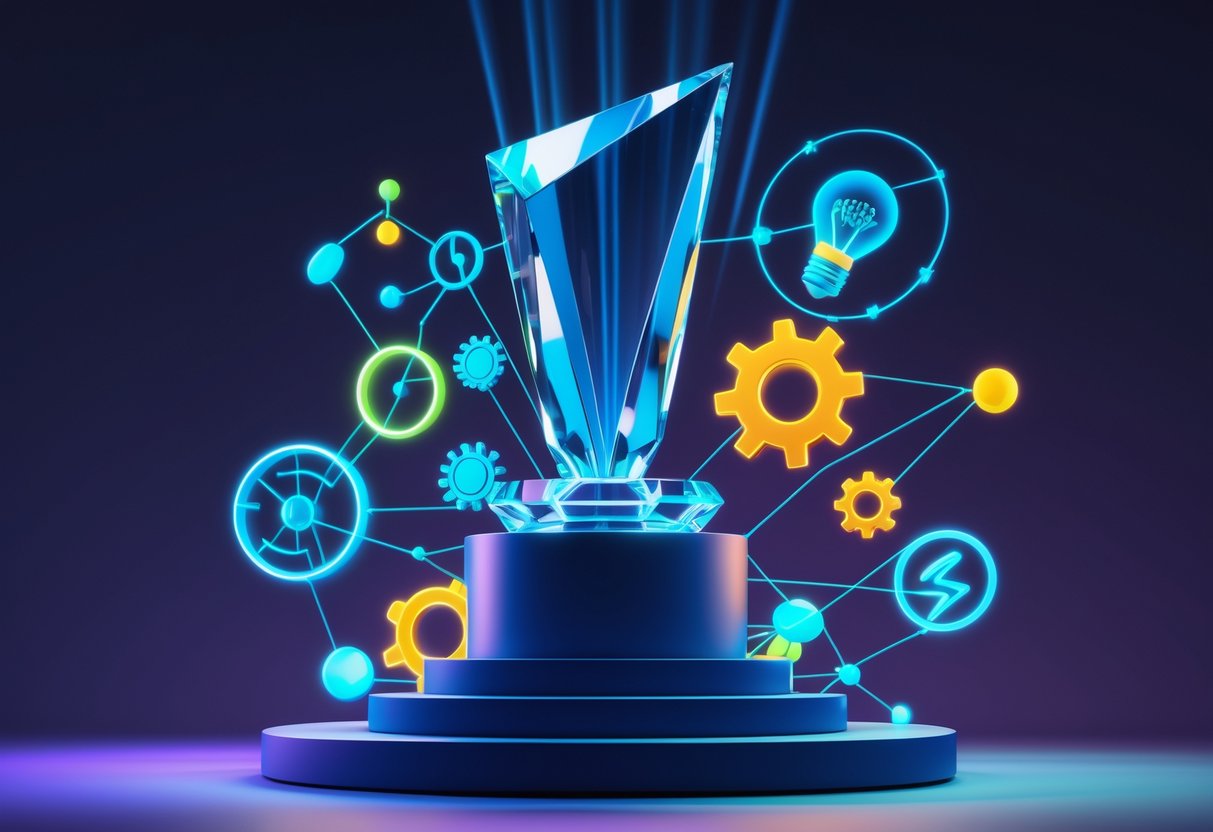Innovation Rewards: Effective Strategies for Motivating Creativity
Updated On: November 13, 2025 by Aaron Connolly
Understanding Innovation Rewards

Innovation rewards give employees structured incentives to spark new ideas and solutions at work.
These rewards help companies build a culture where creativity feels welcome, and teams feel inspired to take smart risks.
Definition of Innovation Rewards
Companies use both formal and informal incentives to push employees to generate, test, and develop valuable new ideas.
These rewards recognise not just successful outcomes but also the lessons learned from failed experiments.
Unlike traditional performance rewards that focus on efficiency and compliance, innovation rewards encourage risk-taking and experimentation.
They reward employees for thinking differently and challenging the status quo.
The big difference? Traditional systems reward flawless execution.
Innovation rewards celebrate smart failures, creative problem-solving, and breakthrough thinking.
These rewards can target several types of innovation:
- Incremental improvements to what already exists
- Adjacent innovations that break into new markets
- Transformational ideas that build entirely new business models
Types of Innovation Rewards
We can break innovation rewards into four main types, each motivating a different side of creative behaviour.
Financial Incentives offer spot bonuses for breakthrough ideas, profit-sharing from new products, and innovation-specific performance bonuses.
Some companies even set up internal venture capital funds so employees can earn equity-like rewards.
Time-Based Incentives give employees dedicated hours for creative work.
The well-known “20% time” model lets staff spend a day per week on personal innovation projects.
Hack weeks and innovation sprints fit here too.
Recognition and Reputation rewards shine a spotlight on creative contributions.
These might include internal awards ceremonies, chances to present ideas to senior leaders, and peer recognition programmes.
Career Incentives connect innovation to professional growth.
Some organisations offer promotion pathways for innovation expertise, rotational programmes through innovation labs, and fast-tracking creative employees into leadership roles.
Purpose and Impact on Organisations
Innovation rewards serve a few crucial purposes that shape organisational success and competitiveness.
Behaviour Change sits at the core.
These rewards help employees shift from “avoid mistakes” to “learn quickly and try new things”.
They nudge teams to collaborate and share knowledge across departments.
Cultural Transformation happens when innovation rewards become part of daily life.
Employees begin to see creativity as a core part of their job, not just an extra task.
Business Impact shows up through more idea generation, faster experiments, and better problem-solving.
Companies with effective innovation rewards usually see:
- Higher employee engagement in creative work
- More collaboration between departments
- Quicker launches for new solutions
- Better adaptability to market changes
The best organisations find a balance.
They celebrate big wins but avoid discouraging teams whose ideas don’t pan out.
Aligning Rewards with Innovation Goals
Innovation rewards only really work when they connect directly to what your organisation wants to achieve.
Clear objectives and good measurement help teams know what behaviours will earn recognition.
Setting Clear Innovation Objectives
Before designing any reward system, we need to define what innovation means for us.
Innovation goals should tie into the business strategy and be specific enough that employees know what’s expected.
Start by sorting innovation into three buckets.
Core business improvements make current processes better.
Adjacent innovations help us step into new markets or serve existing customers in new ways.
Transformational ideas create brand-new business opportunities.
Each category needs its own reward approach.
Spot bonuses might work for core improvements.
Team recognition and career opportunities could suit adjacent innovations.
Transformational projects need longer timelines and should reward learning and experimentation, even when early efforts fall short.
Innovation performance gets better when employees know which kinds of ideas matter most.
We should be clear if we’re focusing on cutting costs, growing revenue, improving customer experience, or boosting efficiency.
Integration with Business Strategy
Innovation culture grows when rewards match the company’s direction.
If digital transformation is the focus, then innovation rewards should highlight technology-based solutions and digital skills.
Set up shared KPIs across departments to encourage collaboration.
When marketing, product, and operations all have innovation metrics, teams are more likely to work together.
Time-based incentives help with strategic alignment.
Give 10-20% of work time to innovation projects that support business goals.
This proves we’re serious about innovation and keeps efforts on track.
Think about your industry’s pace.
Highly regulated sectors need different rewards than fast-moving tech firms.
What works for a startup might flop in a big manufacturing company.
Review your strategy regularly and check if your innovation rewards still fit.
As business priorities shift, your incentives should change too.
Measuring Innovation Success
Good measurement tracks both activity and results.
We need metrics that encourage participation but still focus on quality.
Activity indicators show engagement:
- Number of ideas submitted per employee
- Participation rates in innovation programmes
- Cross-team collaboration on projects
- Speed from idea to prototype
Outcome indicators prove business impact:
- Revenue from new ideas
- Cost savings from process improvements
- Customer satisfaction gains
- Faster time-to-market
Survey employees every quarter about innovation culture.
Ask if they feel safe sharing ideas, if they know what innovation means for their role, and if they see others being rewarded for it.
Set different timelines for success.
Core improvements might show results in months.
Transformational projects could take years.
Adjust reward timing to keep motivation up during long innovation cycles.
Track both wins and lessons from failures.
This balanced approach helps build a culture where smart risks matter as much as big successes.
Designing Effective Reward Systems
Building a reward system that really drives innovation takes careful planning.
We need to tie rewards to the right behaviours, balance different motivations, and make sure everyone sees the process as fair.
Criteria for Selecting Reward Types
Start by matching rewards to the stage of innovation.
Early ideas need different incentives than concepts ready for market.
For experimental projects, focus on learning-based rewards.
Recognise hypothesis testing, protect time for research, and celebrate smart failures that teach valuable lessons.
For proven innovations, use outcome-focused rewards:
- Profit-sharing from new products
- Career advancement for innovation success
- Public recognition from leadership
- Financial bonuses for implemented ideas
Know your audience.
Technical teams often want professional development or conference attendance.
Sales teams might prefer cash rewards or commission tweaks.
Creative teams usually respond to peer recognition and creative freedom.
Different innovation horizons need different rewards:
- Core improvements: Spot bonuses and efficiency metrics
- Adjacent innovations: Cross-team collaboration rewards
- Transformational ideas: Long-term equity stakes and leadership roles
Balancing Intrinsic and Extrinsic Rewards
Don’t just throw money at the problem.
Monetary rewards alone can shrink creative thinking by making people focus too much on the cash.
Intrinsic motivators usually work better for innovation.
These include autonomy, skill development, purpose, and recognition from peers.
Mix both types thoughtfully.
Start with intrinsic rewards to spark interest, then add extrinsic rewards to keep momentum.
Tangible rewards work best when they feel fair and within reach.
A £500 bonus for a breakthrough idea sends a strong message about value without causing unhealthy competition.
Time-based incentives often bridge both worlds.
Google’s “20% time” gives autonomy (intrinsic) and concrete hours (extrinsic).
Ensuring Fairness and Transparency
Publish clear criteria before you start.
Everyone should know what earns rewards.
Offer multiple ways to succeed.
Not every innovator works the same way, so your system shouldn’t favour just one style.
| Innovation Role | Recognition Method | Reward Type |
|---|---|---|
| Idea Generator | Innovation Awards | Public recognition + bonus |
| Collaborator | Peer nominations | Career development funds |
| Implementer | Project success metrics | Profit-sharing |
| Learner | Experiment documentation | Conference attendance |
Keep communication open.
Share stories about why certain projects earned rewards.
This helps everyone understand how decisions are made.
Tackle bias in selection.
Use diverse review panels and structured criteria instead of just manager opinions.
Track who’s participating across teams.
If only certain groups are getting rewards, check for hidden barriers or biases.
Try peer nominations.
Let colleagues recognise each other’s contributions—it’s affordable and builds shared ownership of innovation culture.
Monetary and Tangible Rewards

Companies use both financial incentives and physical gifts to boost innovation.
These rewards deliver instant value and can fire up motivation, but they work differently from recognition-based approaches.
Financial Incentives and Bonuses
Financial rewards give employees direct monetary benefits for their creative work.
These might be bonuses, stock options, profit-sharing, or equity stakes.
Cash bonuses work best when they’re tied to specific innovation goals.
Teams might score £1,000 for launching a new feature or £500 for a solid improvement idea.
Stock options let employees share in long-term company growth.
When their ideas help the business, their personal wealth grows too.
Profit-sharing schemes send a percentage of innovation-driven revenue back to the teams who made it happen.
This ties employee effort directly to business results.
But cash rewards can sometimes feel like “just more salary”.
People often see bonuses as expected pay, not special recognition.
To make financial rewards stand out, announce them publicly or hand them out at company events.
Deliver them separately from regular pay.
Gift Cards and Vouchers
Gift cards sit between cash and physical gifts.
They offer monetary value but limit where employees can spend.
Popular picks:
- Amazon vouchers (£25-£100)
- Restaurant gift cards
- Experience vouchers (spa days, adventure activities)
- Tech store credits
Gift cards feel more special than cash because they nudge people to treat themselves.
An employee might buy something they wouldn’t otherwise consider.
Experience vouchers work especially well for innovation rewards.
They create memories and show the company cares about work-life balance.
The restrictions make gift cards feel separate from regular pay.
This “reward distinctiveness” can actually boost motivation more than plain cash.
Pick vouchers that fit your team.
Tech folks might want electronics; creative types might appreciate art supplies.
Physical Gifts
Tangible rewards create lasting reminders of innovation.
These might be branded merchandise, electronics, or luxury items.
Examples:
- Branded laptops or tablets
- Premium headphones
- Company sweatshirts and accessories
- Personalised plaques or trophies
Physical gifts work because they’re visible.
A new laptop or branded jacket signals to others that innovation gets noticed.
Quality beats price.
A well-made £50 item often feels more valuable than a cheap £100 one.
Personalisation makes a big difference.
Engrave the employee’s name or project on the reward.
Consider gifts that help with daily work.
Ergonomic keyboards, good monitors, or premium software show ongoing support.
Novelty matters here.
Unlike cash, tangible rewards stick around and keep the achievement visible.
Non-Monetary Recognition Programmes
Recognition programmes that skip cash rewards can build a strong innovation culture by making employees feel genuinely valued for their creativity.
These programmes focus on visibility, growth, and skill development to reward those who push innovation forward.
Public Acknowledgement
Public recognition shines a light on innovative employees who go above and beyond. It taps into our natural need for appreciation and respect from colleagues—who doesn’t want to feel valued?
Employee of the month programmes work best when they highlight real innovation. Feature winners on company websites, newsletters, or even on the office wall, and add a few lines about what they did differently.
Innovation showcases invite employees to present their ideas directly to senior leaders. Many companies hold quarterly innovation fairs so staff can show off new solutions or improvements they’ve created.
Peer-to-peer recognition systems let colleagues nominate each other for innovation awards. Digital platforms make it simple for teams to celebrate creative problem-solving in real time.
Companies like Intuit even hand out “failure awards”—they celebrate teams whose unsuccessful projects led to valuable lessons. That takes the fear out of taking creative risks.
Career Advancement Opportunities
Career development focused on innovation tells employees we’re serious about their creative thinking. It connects innovation directly to professional growth.
Fast-track promotion programmes spot employees who consistently bring new ideas to the table. Lay out clear paths that show how innovation skills can lead to leadership roles.
Innovation leadership roles offer creative thinkers the chance to lead special projects. This could mean heading up innovation committees or mentoring others in creative problem-solving.
Cross-department assignments give innovative employees exposure to different parts of the business. This widens their perspective and spreads a culture of innovation across teams.
Conference attendance and speaking opportunities let innovative employees share their expertise outside the company. It boosts their professional reputation and shows off your organisation’s innovation chops.
Personal Development Rewards
Skill-building opportunities motivate employees who want to grow as innovators. These rewards invest in long-term development and strengthen your innovation pipeline.
Training programmes and workshops focused on creativity, design thinking, or new tech really appeal to innovation-minded staff. Partner with universities or specialist providers for high-quality programmes.
Innovation time allowances give employees dedicated hours to work on personal projects or new ideas. Google’s famous “20% time” led to products like Gmail and AdSense.
Mentorship programmes connect innovative employees with senior leaders or external experts. This guidance builds valuable professional relationships.
Educational course sponsorship for innovation-related subjects shows you’re serious about employee growth. This might mean design courses, tech certifications, or business innovation qualifications.
Fostering a Culture of Innovation
Building an innovation culture means weaving new thinking into company values, creating safe places for experimentation, and treating failures as learning opportunities. These three pillars shift how teams tackle creative problem-solving and breakthrough ideas.
Embedding Innovation in Organisational Values
We have to make innovation a core part of what our organisation stands for—not just a buzzword in meetings. Write innovation into the company mission statement and values.
Make it visible everywhere. Put innovation goals on office walls, in email signatures, and during onboarding. New hires should know right away that creative thinking matters here.
Google shows this by giving employees 20% of their time for personal projects. That policy proves innovation isn’t just encouraged—it’s expected and backed by real resources.
Set clear innovation metrics. Track how many new ideas people submit each month. Measure how quickly we test new concepts. Count patent applications or process improvements.
Leaders need to model innovative behaviour every day. When managers ask, “what if we tried this differently?” in meetings, it signals that questioning the status quo is a good thing.
Let’s celebrate innovation attempts, not just the wins. Share stories about failed experiments that taught us something new.
Promoting Psychological Safety
Psychological safety means people feel okay sharing wild ideas without worrying about ridicule or punishment. Research says teams with high psychological safety create 76% more innovative solutions. That’s a big difference.
Create “no judgement” brainstorming sessions. Set ground rules—everyone’s ideas get heard before anyone critiques. Try silent brainstorming where people jot down ideas anonymously first.
Managers can ask, “what’s one crazy idea that might work?” instead of jumping straight to what’s wrong. That little shift turns the conversation from criticism to possibility.
Respond positively when someone admits they don’t know something. Saying, “that’s a great question,” not only encourages honesty, but also invites more open dialogue.
Build failure tolerance into job descriptions. Some companies now list “comfortable with ambiguity” and “learns from mistakes” as required skills for innovation roles.
Regular team check-ins should include questions about what experiments people want to try. This normalises the idea that everyone can test new approaches.
Encouraging Risk-Taking and Learning
Innovation means taking smart risks and learning fast from the results. We need systems that reward thoughtful risk-taking, even if things don’t work out.
Start with small, reversible experiments. Test new ideas with limited budgets and short timelines. Amazon’s “two-way door” decisions work well—if we can easily undo it, why not try?
Celebrate smart failures publicly. Share stories in company newsletters about experiments that didn’t work but taught us something useful.
Provide learning budgets for experimentation. Give teams £500-1000 each quarter to test new tools, attend workshops, or try different approaches.
Host “failure parties” where teams present what went wrong and what they learned. It takes the shame out of mistakes and helps others avoid the same pitfalls.
Track learning speed alongside traditional metrics. How quickly can our teams test ideas and get feedback? Often, speed of learning predicts long-term innovation.
Teach teams to see setbacks as data points, not defeats. Every failed experiment brings us a step closer to a solution that actually works.
Collaborative Innovation and Team Rewards

Team-based reward systems push groups to work together instead of competing. These systems thrive when they include shared goals across departments and peer recognition.
Team-Based Reward Approaches
Team rewards focus on collective success rather than individual wins. Employees start sharing ideas and building on each other’s work.
Shared KPIs work better than individual targets for innovation projects. Teams with common goals naturally collaborate more. For instance, measuring “ideas implemented per quarter” as a team target instead of individual output.
Group bonuses tied to innovation outcomes get everyone involved. A pharma company gave shared rewards to cross-functional teams that finished drug trials ahead of schedule. Each team member got the same bonus, no matter their specific role.
Time-based team incentives give groups dedicated time for innovation. Some companies host “hack weeks” where whole departments focus on creative solutions. These bursts often spark ideas that regular routines just don’t.
Teams should get recognition together to keep unity strong. If one person gets celebrated while others contributed just as much, future collaboration can take a hit.
Cross-Functional Collaboration
Cross-functional teams blend different skills and perspectives for stronger innovation. Reward systems should encourage people to step outside their usual roles.
Rotation programmes let employees experience other parts of the business. Engineers who shadow customer service often design more user-friendly products. Marketing folks who work with operations create more realistic campaigns.
Joint performance reviews measure how well someone supports other departments. An IT specialist might get evaluated on how effectively they helped sales implement new tools.
Collaboration bonuses reward people for helping teams outside their area. Some companies track internal consultation requests and reward employees who frequently pitch in across departments.
Shared project ownership means multiple departments share credit for innovations. Instead of one team claiming victory, everyone involved gets recognised and rewarded.
Peer-to-Peer Recognition
Employee-driven recognition often motivates innovation better than top-down rewards. Colleagues see the daily grind and can spot contributions that managers might miss.
Nomination systems let employees recommend teammates for innovation awards. These often highlight behind-the-scenes contributors who make things happen but rarely get the spotlight.
Point-based platforms allow team members to give each other recognition points that turn into rewards. Platforms like HeyTaco make peer appreciation visible and build stronger connections.
Innovation showcases let employees present colleagues’ ideas to leadership. When team members advocate for each other’s work, it shows real collaboration and trust.
Peer feedback integration brings colleague input into formal performance reviews for innovation. This way, reward systems capture the full picture of how someone contributes to creative teamwork.
Supporting Innovation Projects and Sprints

Innovation projects need structure and clear rewards to thrive. Good sprint programmes, proper resource allocation, and milestone celebrations keep up momentum and drive creative solutions.
Innovation Sprints and Competitions
Innovation sprints bring teams together for focused problem-solving. These events usually last 3-5 days and follow a simple process for developing creative solutions.
Design sprints work well for innovation projects. Teams define challenges, brainstorm, prototype, and test ideas quickly. This setup empowers people and makes them feel valued.
Key sprint elements include:
- Clear problem definitions
- Cross-functional team participation
- Rapid prototyping tools
- User testing sessions
- Decision-making frameworks
Innovation competitions take the sprint concept company-wide. Teams submit ideas and compete for recognition and resources. The best competitions strike a balance between collaboration and healthy rivalry.
It’s usually better to set specific themes for sprints instead of leaving them wide open. Focused creativity leads to more useful results.
Resource Allocation and Sponsorship
Innovation projects need dedicated resources to move from idea to action. Smart allocation means financial support and executive sponsorship.
Executive sponsors play a crucial role for innovation. They remove barriers, secure funding, and champion projects at the top. Without their backing, even great ideas can stall.
Essential resources include:
- Time allocation – 10-20% dedicated innovation time
- Budget provision – Seed funding for prototypes and testing
- Technical tools – Software, equipment, and platforms
- Expertise access – Subject experts and mentors
Portfolio thinking works best for funding. Place many small bets at first, then double down on projects making progress. That reduces risk and maximises returns.
Keep resource allocation transparent and fair. Set clear criteria for funding so teams know what’s needed for support.
Celebrating Project Milestones
Celebrating milestones keeps innovation alive and teams motivated during long projects. Recognition at key stages boosts momentum and encourages more risk-taking.
Effective milestone rewards include:
- Public recognition – Team presentations to leadership
- Learning opportunities – Conference attendance or training
- Project showcases – Internal demo days and exhibitions
- Career advancement – Promotions or new roles
Celebrate both successes and valuable failures. Teams that take risks and learn from setbacks deserve recognition just as much as those who hit it big.
Quick wins matter too. Acknowledging small progress keeps everyone engaged and shows that all contributions count.
Regular showcase events create excitement and friendly competition. Monthly demo days or quarterly innovation fairs give projects visibility and something to aim for.
Innovation Programmes and Initiatives

The best innovation rewards depend on well-structured programmes that balance recognition with ongoing improvement. The most effective approaches mix clear frameworks with proven examples and systematic feedback from participants.
Structuring Innovation Programmes
We build innovation programmes around three core horizons, each needing its own reward approach. In Horizon 1, we focus on core business improvements, rewarding efficiency gains and small steps forward.
Horizon 2 targets adjacent innovations, so we recognise cross-functional collaboration and market expansion. For Horizon 3, we reward transformational ideas by encouraging learning speed and strategic risk-taking.
Every horizon needs its own timeline and success metrics.
Time-based incentives usually work well across the board:
- 20% time set aside for personal innovation projects
- Quarterly innovation sprints
- Protected research periods
- Hack weeks with specific themes
We guide participation using clear governance models. Teams send in their ideas through standardised processes, and we use transparent criteria to evaluate them.
Recognition programmes highlight both successful outcomes and smart failures that teach us something valuable.
Financial incentives show up as spot bonuses for high-impact ideas and profit-sharing for new business models. For career-based rewards, we tie innovation skills to promotion criteria and leadership development.
Best Practice Examples
Some leading organisations show how to run innovation reward systems with a mix of approaches. For example, a global pharmaceutical company created an “Intelligent Failure Award” for teams that ran rigorous experiments and shared insights, even when projects didn’t succeed commercially.
Technology companies often set shared KPIs across departments for innovation goals. That encourages collaboration between groups like IT, operations, and finance.
Successful programme elements include:
- Internal venture capital with equity-like rewards
- Peer recognition for helping others’ ideas
- Fast-tracking high-potential innovators up the career ladder
- Public acknowledgment from leadership for hitting innovation milestones
Financial services firms tie innovation bonuses to measurable outcomes. Manufacturing companies lean toward team bonuses for pilots that cross business units.
Many organisations use both monetary and non-monetary incentives. Innovators get to pitch ideas to senior executives and sometimes move laterally into ventures, product teams, or research roles.
Utilising Feedback for Improvement
We track activity and outcome indicators to keep making innovation programmes better. Early signals come from the number and quality of idea submissions.
Participation rates in innovation activities show whether incentives actually motivate people.
Employee surveys help us measure how folks feel about innovation culture and programme effectiveness. We also watch the speed of experimentation cycles to avoid unnecessary delays.
Key feedback metrics include:
- Revenue or cost savings from implemented innovations
- Cross-functional collaboration rates
- Time from idea submission to decision
- Employee satisfaction with recognition
Regular feedback collection shows us where gaps exist between business units and innovation horizons. We tweak incentive models based on what motivates each team.
Quarterly reviews help us see if financial, time-based, recognition, and career incentives are working as intended.
Motivating Employees for Continuous Innovation

Long-term innovation only works if employees stay engaged after the initial excitement fades. We need personalised approaches that recognise different preferences and celebrate both small daily wins and major breakthroughs.
Sustaining Motivation Over Time
Innovation motivation drops off if we don’t have solid support systems. We have to create engagement cycles that keep momentum going after project launches.
Regular feedback keeps things visible. Weekly check-ins and monthly reviews remind everyone that innovation matters for the long haul.
Rotation programmes help prevent burnout and spark new ideas. Moving people between innovation projects every 6-12 months brings fresh energy and new perspectives.
When we tie career advancement to innovation performance, employees see real paths for growth. That way, innovation becomes part of their professional development, not just extra work.
Recognition programmes need to keep evolving. What excites employees today might feel stale next year. Regular surveys help us keep up with changing preferences.
Personalising Rewards to Individuals
Everyone likes different kinds of recognition. Some prefer public praise, others want a quiet thank you. Understanding what people actually want makes rewards stick.
Generation-based preferences can steer reward choices:
- Younger employees often want learning opportunities and flexible work
- Mid-career folks look for leadership roles and skill growth
- Senior employees might like mentoring and legacy projects
We can offer reward menus so employees pick what suits them best. Options could be conference trips, extra time off, or special project assignments.
Skills-based matching pairs innovation opportunities with what people enjoy. Engineers might dig technical challenges, while marketing staff love creative campaigns. Matching projects to strengths usually boosts engagement.
Regular one-on-ones help managers figure out what motivates each team member. These chats reveal shifting priorities and guide reward tweaks.
Recognising Everyday Innovative Efforts
Small, daily innovations often matter more than the rare big breakthrough. We need to celebrate those incremental improvements and creative problem-solving in everyday work.
Micro-recognition systems let us acknowledge small wins right away. Digital platforms can track and reward daily process tweaks or creative fixes. Quick feedback keeps momentum alive between big milestones.
Peer nominations let colleagues highlight each other’s innovations. These grassroots shout-outs often catch things managers miss and build a culture of appreciation.
Innovation storytelling spreads examples of everyday creativity. Monthly newsletters or team meetings can spotlight how tiny changes made a real difference. These stories inspire others and show that every contribution counts.
Department-level innovation challenges focus on practical improvements, not just moonshots. Teams compete to solve common problems or streamline something clunky. This way, everyone gets in on the action.
Challenges and Solutions in Rewarding Innovation

A lot of innovation reward programmes flop because they focus on the wrong behaviours or cause side effects nobody wanted. The main challenges? Avoiding pitfalls that kill team spirit, handling failures without crushing morale, and adapting reward systems as organisations change.
Overcoming Common Pitfalls
Individual-focused rewards can backfire. If we only reward the person who submits an idea, we discourage teamwork and idea refinement.
Most raw ideas need a lot of development. If only the original creator gets credit, others won’t bother to help improve things.
Money isn’t a great motivator for creativity in most stable jobs. Research even suggests financial incentives can hurt creative output.
Cash rewards might cause a quick spike in engagement, but it fades fast. Once the money’s gone, participation tends to drop below where it started.
Common mistakes to avoid:
- Focusing on idea quantity, not quality
- Ignoring the work needed to implement ideas
- Relying only on cash incentives
- Turning innovation into a competition instead of a team effort
Better ways to do it:
- Team-based recognition for whole project groups
- Career opportunities like leading implementation
- Public recognition from senior leaders
- Time set aside for innovative work
Managing Unsuccessful Initiatives
Failed innovation projects need careful handling if we want teams to stay resilient. How we respond shapes whether people try again.
Don’t punish smart failures. If a well-researched project flops, we should celebrate the lessons, not assign blame.
Throw a “failure party” or hold a retrospective. These sessions help teams pull out the learnings and keep up their energy for next time.
Document what didn’t work and spread those insights across the organisation. That way, others don’t repeat the same mistakes.
Redirect, don’t abandon. Even failed projects usually have useful parts that can help elsewhere.
Support the team by moving them quickly onto new innovation opportunities. This helps people stay bold and avoid getting risk-averse.
Adapting to Organisational Change
Our reward systems have to shift as company priorities and structures change. Static recognition quickly falls out of touch.
Regular reviews help us see if rewards still fit business goals. We check effectiveness every six months or so.
Cultural changes mean reward changes. If we’re flattening the hierarchy, our recognition needs to reflect that.
Different teams need different things. Sales might like competitive rewards, while research prefers collaborative recognition.
Scale matters. What works in a startup won’t fly in a giant corporation.
Keep the core principles steady—focus on intrinsic motivation and culture—even as the methods shift.
Build flexibility in from the start. That way, we can adjust quickly without starting over.
Frequently Asked Questions

Companies setting up innovation rewards run into the same questions about measuring impact, picking platforms, and tracking progress. Here are some real-world concerns, from culture-building to community voting systems.
How can a culture of enquiry enhance a company’s innovative capacity?
A culture of enquiry builds psychological safety, making it okay for employees to ask questions and challenge how things are done. This kind of environment sparks more breakthroughs and creative solutions.
When we encourage everyone to question things, teams uncover problems nobody even saw before. Those discoveries often lead to the most valuable innovations.
Companies that reward curiosity—not just results—see more improvements driven by employees. Recognition programmes that celebrate good questions, not only good answers, help set this up.
Regular “why” sessions and structured questioning give teams tools to dig deeper before jumping to solutions.
What are the categories for innovation awards in gaming platforms like Roblox?
Gaming platforms usually split innovation awards into technical achievement, creativity, and community impact. Roblox, for example, recognises breakthrough game mechanics, visual design, and social features that bring players together.
Popular categories include Best New Developer, Most Innovative Gameplay, and Outstanding Community Building. Some platforms also highlight accessibility improvements and educational games.
Technical awards go to new programming tricks or better performance. Creative awards celebrate unique art, storytelling, or user experience.
Community-driven awards let players vote for their favourites, which sometimes brings out different winners than the expert panels.
How can one check the balance of awards linked to innovative projects or programmes?
Most digital reward platforms have dashboards where you can see your current balance and transaction history. They usually send email alerts when you get new awards.
Corporate innovation programmes often link up with HR systems, so employees check their reward status through company portals or apps.
For external competitions, organisers set up participant portals with real-time balance info. For bigger awards, payment might take a few weeks.
Always double-check payment details and tax stuff before jumping into innovation award programmes. Different awards pay out on different schedules.
What are the latest trends in recognising innovation within the tech industry?
Tech companies are using more peer-to-peer recognition platforms, letting people give instant props for innovation. These systems catch creative moments that annual reviews miss.
Real-time recognition—digital badges, micro-rewards—keeps momentum up. Teams can celebrate small wins right away instead of waiting for review cycles.
A lot of firms now track innovation metrics alongside recognition data to spot patterns. This helps them see which recognition methods actually boost creativity.
Experience-based rewards—like sending someone to a conference or giving learning opportunities—are getting more popular than just handing out cash. Tech folks often want skill growth more than bonuses.
How does voting for innovation awards work on platforms that involve community participation?
Community voting usually happens through secure online platforms, where people register and verify who they are. Each voter typically gets one vote per category to keep things fair.
Some platforms use weighted voting, so long-time community members or pros have a bit more influence.
Voting windows last a couple of weeks, with clear deadlines and open counting. Some contests mix community votes with expert panel decisions.
To prevent cheating, platforms track IP addresses and verify accounts. They flag suspicious voting before announcing results.
What applications are available for tracking rewards and recognitions in South Africa?
A bunch of South African companies actually offer employee recognition platforms—Motivate and RecogniseMe come to mind, plus you’ll find local branches of global providers like Achievers. These platforms handle different currencies and stick to local labour rules.
Providers like Kudos and Bonusly have mobile apps that work pretty well for remote teams in South Africa. They let you give rand-denominated rewards and hook into local payment systems.
Some organisations go for custom-built solutions that link directly with South African payroll systems and tax requirements. Honestly, these often handle compliance a bit better than the big international platforms.
In the gaming and tech scene, people usually pick international platforms—think Discord bots or Steam achievement systems—especially for innovation competitions. Local esports tournaments? They tend to rely on their own custom registration and tracking setups.

